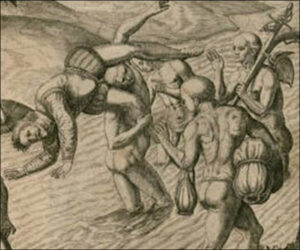On departing St. Croix, Columbus’s fleet coursed east over the next few days toward “Española.” While primary sources differ, my estimation is that Columbus now held almost thirty indigenous people seized or taken aboard at Guadeloupe and St. Croix. Some were Caribes, who understood they were captives. Others were Taínos previously enslaved by Caribes who had sought asylum with Columbus to escape the Caribes—likely unaware that they would remain captives of Columbus instead.
On November 19, 1493, 528 years ago, the fleet came to an island some of the Taíno women and boys aboard called home—Boriquén—and the ships anchored on its western coast for two days. Columbus named the island San Juan Bautista (Saint John the Baptist), now called Puerto Rico. On the night before the fleet sailed for Española, the Boriquén women and boys realized Columbus wouldn’t liberate them, and three jumped overboard to swim home.
Columbus and Caonabó: 1493–1498 Retold weaves forty-two maps and historic illustrations into the story, including some depicting events that occurred in later Spanish conquests because primary sources establish similar events did occur in Española (although not illustrated). One of these illustrations is taken from the conquest of Puerto Rico, depicting Boriquén ambushing and killing a conquistador in 1510, shown below (taken from Theodor de Bry, courtesy of the John Carter Brown Library, Providence, Rhode Island).

